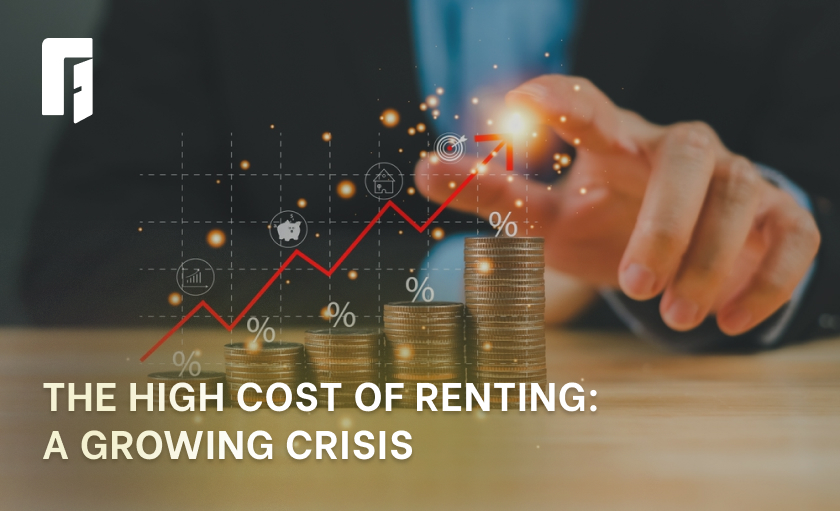The high cost of renting homes has shot up by 26-67 percent, leaving people with little money to spend on other things.
High cost of Renting: Report by Anarock and Knight Frank
Data from property expert Anarock shows that rents for homes have increased between 26% and 67% in the last three years in key micro markets in India’s seven biggest cities.
Knight Frank, India’s National Director of Research, Vivek Rathi, said, “Cost of renting has increased a lot in cities like Bengaluru and Gurugram over the past two years.”
Soaring Rents Squeeze Urban Households
The sharp increase in the high cost of renting is having an increasingly larger impact on the current incomes of the population that rents.
According to Rathi of Knight Frank, “It reduces their budget for discretionary expenses such as entertainment and vacations”
“But the largest casualty is very likely their savings and investments, particularly in the low and middle-income demographic.”
“This is even though overall sentiments regarding the economy and income growth continue to be positive.”
Concerns have been made recently by the leaders of key consumer goods and fast-moving consumer goods businesses regarding the weak demand from urban consumers and the “shrinking middle class.”
They attributed the slowdown to a variety of factors, such as floods that occurred during the September quarter, inflation in the food market, and a decline in the need for individuals to spend their discretionary income.
People who live in cities like Mumbai and the National Capital Region, where the cost of real estate is high, end up spending almost half of their salary on rent.
High Cost of Renting: Rents in India cross pre-pandemic level in Office space(Colliers Report)
Across all six major office markets (Delhi, Chennai, Mumbai, Bengaluru, Hyderabad, and Pune), the average rentals have topped the pre-pandemic levels (2019) for the first time in 2024.
According to a survey conducted by Colliers, a real estate consultancy firm. This is due to the fact that demand has been robust and steady.
“The rental recovery in the Indian office market, albeit relatively slower than the demand recovery trajectory has finally been fully complete, thus forming an elongated ‘U-shaped’ pattern,” according to the research conducted.
In the year 2022 alone, certain cities, such as Hyderabad and Pune, were able to achieve rental levels that were comparable to those that existed before the epidemic, and this restoration track was maintained throughout its duration.
The Delhi National Capital Region and Mumbai, on the other hand, eventually completed the recovery cycle in the year 2024, while Bengaluru and Chennai broke past the 2019 rental levels in the year 2023.
It is interesting to note that certain core micro markets in the top six cities have had rental growth of up to 25 percent from 2019 to 2024.
Over the same time period, these micro-markets have had stronger rental growth compared to the city-level appreciation of between 2 and 8 percent. This is because these micro-markets have seen robust demand across all occupier segments.
Since the year 2019, the six major office markets Bengaluru, Chennai, Delhi, Hyderabad, Mumbai, and Pune, have already witnessed a total demand for Grade A office space that amounts to 264 million square feet.
This demand has been maintained by the market’s sustained strong momentum, pushing the high cost of renting office space according to Colliers.
High Cost of Renting Across Cities: Burdening Tenants
An analysis of the Anarock data revealed that the monthly rents have experienced the most significant increase in Bengaluru.
Particularly in areas such as Sarjapur Road, where they have increased by 67% to ₹35,000, and Thannisandra Main Road, where they have increased by 56% to ₹32,000.
Rentals in Chennai have climbed by 33-40 percent, reaching ₹20,800-21,600 in regions such as Pallavaram and Perambur.
Additionally, rentals in centrally placed areas like Anna Nagar have gone to Rs 25,000 for a two-bedroom, two-bathroom apartment, presuming that the apartment is equipped with top amenities.
The real estate market in Mumbai is among the most expensive in the world, and the recent increase in the number of premium gated projects that offer a variety of amenities has led to an increase in real estate rental prices.
In the eastern suburb of Mulund, rent has increased by 26%, reaching close to Rs 50,000, while in Chembur, which is located in the center of the city, it has increased by 38%, reaching over Rs 63,000 respectively.
In spite of the demand lulls that occurred during the years that were hit by the pandemic, the uninterrupted record-breaking leasing activity has been important in maintaining the economic pace.
The fact that the cumulative demand-supply ratio for the period of 2019-2024 is 1.1 makes it abundantly evident that supply infusion has greatly followed demand revival demonstrates this fact.
This is the situation while looking at the whole picture. On the other hand, an investigation into the demand and supply contours at the city level shows several fascinating aspects.
Because demand has greatly exceeded supply, Mumbai has experienced a considerable decrease in the number of vacant units since the year 2019, when the demand-supply ratio was 2.1.
Similarly, in the Delhi-National Capital Region (NCR), where demand consistently exceeds supply, the number of vacant positions has decreased from approximately 25% a few years ago to approximately 20% at the present time.
On the other hand, Hyderabad has historically been a market with a strong supply, and this has resulted in vacancy levels that are constantly increasing; the present vacancy levels in the city are approximately 25 percent.
Find properties for sale in Chennai, Hyderabad, Bangalore, and Coimbatore at Roofandfloor.com property portal.

